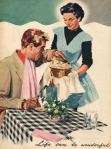The Starched Apron
I have to admit that when signing up to take Latin American Gender and Sexuality, I had no idea what to expect. Sure, the terms sex and gender are thrown around all the time by history books, but I rarely bothered to delve any further into discovering the possible meanings or significance these words held. The term sex is used to describe the physical characteristics of men and women and here I naively sat, thinking there were only two possibilities. The lines have been blurred, and black and white are no longer the only colors in my mind. There is a whole other world completely shaded in grey, making all the clear set images our society has previously portrayed of men and women seem slightly empty and left wanting. Yet, this doesn’t even touch the idea of gender, which is more like the social construct of what men and women are expected to be. There is so much more wrapped up in that tiny word than its length first implies. Gender encompasses a whole range of ideas and thoughts that span centuries and geographical location. The complex details have not remained static throughout the whole of history, and though relatively ignored by many before this “age of feminism,” it turns out, obviously enough that gender and a society’s concept and understanding of the male and female has long affected human action, thought, and lifestyle.
It all became so much clearer when this realization dawned on me during our class discussions this past week. Of course the study of gender and sexuality of any culture must be studied in order to fully gain a better understanding of that society and the world they inhabited. As obvious as it all appears, it seems a vital component often left out or maybe not fully appreciated when studying history. Joan Scott argued that gender was a “key category of historical analysis,” and that it was vital to study how “femininity and masculinity were culturally constructed in relation to each other in different societies.”
I’m so often guilty of seeing the 1950s woman in the housewife ad; flowered apron, rosy red lips, and perfectly coiffed hair, when imagining what characteristics women should possess to successfully fill out the role our gender calls for. Thankfully, the reality of that particular vision has faded somewhat from our society yet, we are still very much governed by these strict ideas of what is appropriate for men and women. These social constructs that bind our mind and actions have done the same in different ways in every culture across time. Anything from the ideal body image, to women’s role as a wife, mother, mistress, provider of the household, and position in political society has had a profound impact on the society as a whole.
Having opened the proverbial can of worms, I am now ready and excited about studying looking further into the idea of gender and sexuality and the part they played in early Latin America.

